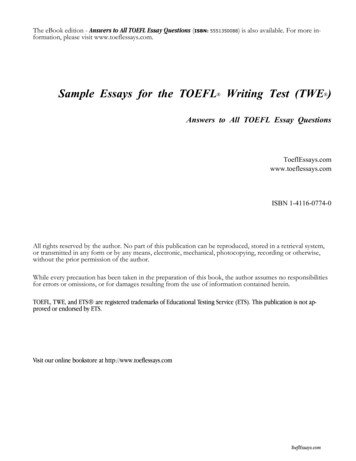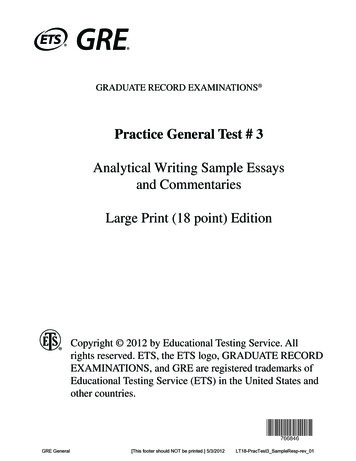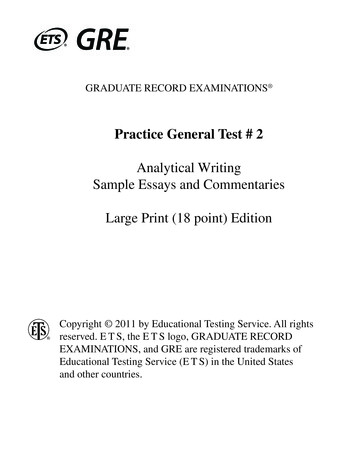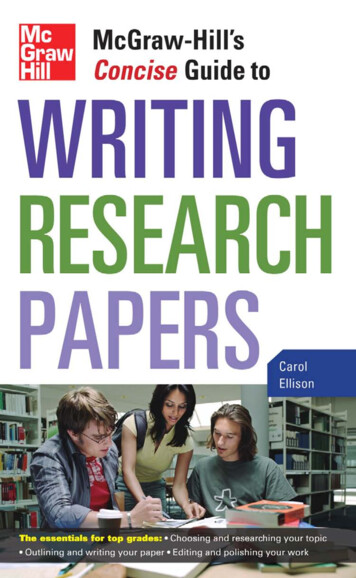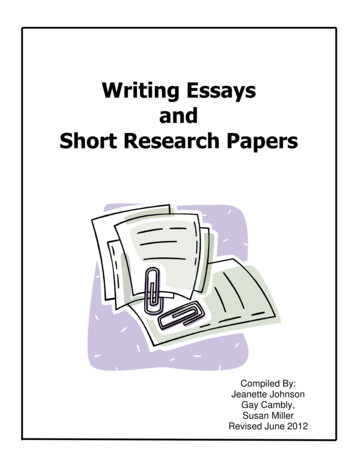
Transcription
Writing EssaysandShort Research PapersCompiled By:Jeanette JohnsonGay Cambly,Susan MillerRevised June 2012
2TABLE OF CONTENTSTABLE OF CONTENTS2INTRODUCTION3VERIFYING INSTRUCTIONS4APPROACHChoose a TopicBrainstormTentative OutlineSet DeadlinesResearchFinal OutlineRough DraftRevise and RewriteProofread DraftFinal CopyProofread Final Copy455666677777CONTENT of Essay8 – 11Sample OutlineIntroductionThesis StatementSample Thesis StatementsBodySummary or Conclusion89991010 - 11Transitional Words11A Writer’s Checklist12MLA FormatTitle PageOpening PageSample Opening PageSample Works Cited Page13 - 1513131415APA FormatSample First PageGeneral Rules for Reference PageSample References PageSummary16 – 1916181920
3INTRODUCTIONThis booklet has been developed to assist youin writing essays and short research papers.The information presented here is a condensationof material contained in several resource booksdealing with college study skills.A complete listing of these books can be found in the References and WorksCited pages at the end of this booklet.If you would like more detailed informationon writing essays and research papers,please contact the Learning Skills Advisorin the Academic Support Centre at 475-6618.For additional copies of this handout and detailed handouts on ModernLanguage Association (MLA) and AmericanPsychological Association (APA) formatting styles,access the Academic Support Centre website centre/learningskills/LearningSkillsResources
4Verifying InstructionsOnce you have been assigned to write an essay paper, be sure that you understand all of theinstructions and know exactly what is expected of you.Be sure you know such things as: whether there is an assigned topic or whether you are free to choose one type of essay required - e.g. descriptive, narrative, persuasive, explanatory the depth to which the instructor wants you to examine the topic whether you are required to give your own opinions length of the essay ( i.e. number of words or number of pages ) format required by the instructor, including ( if applicable) cover pagetable of contentsspacingendnotes or referencesworks cited due date how much the essay counts toward your final grade. (This will give you an indication ofthe time and effort required).ApproachThe following plan of approach will assist you in completing your assignment. Thesteps may be adapted to suit your requirements ( e.g. if the research is not required,omit step 5 ).Choose a TopicIf the topic is not assigned, choose a topic. Something you are interested in or would like to know more about Topic should be relevant to the course ( e.g. don’t write about “Scuba Diving”for a psychology course ) Get the teacher’s approval after selecting your topic
5Approach continuedBrainstormBrainstorm on your topic. Write a list of everything you can think of on your topic. Don’t worry aboutorder - just get as many ideas down as possible. Or write a list of questions you would like to answer. Consider such aspectsas who, what, where, when, why, how, and so what.Bearing these points in mind, brainstorm ideas.Example:Consider the essay instruction:“Discuss how education has changed over the last fifty years”You should be able to write something about this topic. The essay requires you todiscuss how something has changed – the process of education, and the material isto be limited specifically to the last fifty years. What has changed, to what extent, andwhat remained the same? What is education?Listing Brainstorming Ideas: types of education – elementary, high school, postsecondary changes in levels of education changes in access from privileged few to everyone – public vs private global perspective – local, national, internationalBrainstorming shows you what you already know; to develop your answer further, youneed to decide what more you must find out. At this stage, you simply write down thequestions to which you will seek answers. Such questions are valuable because theywill guide your reading and research and help you to collect the material you need.Tentative OutlineMake a simple tentative outline to guide your research. List the major items which came out of your brainstorming in the order youthink they should be discussed. If you have thought of sub-ideas or examplesat this stage, organize them under the appropriate major headings.Decide on your working thesis statement (see page 7). This focused statement prepares both you and your reader for the essay. Your thesis statement helps you keep track of your purpose and organization,and gives the reader an overview of what is to come.
6Approach continuedSet DeadlinesSet deadlines or time allotments for the following major tasks: Research Final Outline Putting it all together (writing the essay or paper using word processor) Typing Proofreading Revise and Rewrite (scheduled over a day or more)ResearchResearch your topic and record the information. Resources you might consider in your research are:1. Your textbooks2. Resource people in the community3. Family and friends4. Library (school and/or community). Look for encyclopedias, books,articles, pamphlets, audiovisual material. When in doubt, tell the librarianyour topic and ask for assistance in locating appropriate resources.5. InternetMake notes on the information pertinent to your topic. Record the title, author,publisher, place and date of publication, and page number of every resource you usebecause you will need this information in referencing. Refer to your tentative outline and thesis statement frequently while doing yourresearch to keep yourself on track.Final OutlineMake a final outline to guide your writing. Organize the ideas from your brainstorming and research into a logicalsequence. Adjust your thesis statement if necessary. Select the principal points you want to make and list them as main headings onyour outline. List supporting details, examples, and explanations for each principal point. EVEN IN THE OUTLINE FORMAT, EACH PARAGRAPH MUST BEGIN WITH AMAIN-IDEA SENTENCE OR A MAJOR POINT THAT SUPPORTS YOUR THESIS.
7Approach continuedRough DraftWrite a rough draft, using your outline as a guide. Put your ideas down on paper, rapidly and spontaneously, according to thesequence of your outline. Don’t be concerned with exact word choice or punctuation. These can becorrected later. Explain each idea completely. Where appropriate, include examples, reasons,descriptions or other supporting information.Revise and RewritePut rough draft aside, then revise and rewrite. Leave the draft overnight or for a few days. Revise and rewrite to improve organization, logic and flow, sentence structure, andwording. (see page 11).ProofreadProofread final draft, consider the following mistakes: Formate.g.- citations (some of the phrases may have been taken from thesources, but not formatted properly. It is considered as plagiarism.)- page numbers (make sure the order is correct)- title page, reference page (your title page and reference page shouldbe formatted according to the requirements established by yourinstructor) Grammare.g.- grammatical mistakes (wrong use of tenses etc.)- spelling mistakes- punctuation- abbreviations (abbreviations should be explained; e.g. SUCCI:the Student Union of Confederation College Inc.) Writing stylee.g.- misused words- text flow Organizatione.g.- logical sequence (the essay should be presented in a logical chain)- unity (your essay should be logically connected text, but not separateideas)- headings (follow a consistent formatting style)- clear statement of the thesisFinal CopyRecopy or type the final copy.ProofreadProofread the final copy.*TIP - consider reading your essay backwards!
8ContentThe content of an essay or research paper should include an introduction, the body or“meat” of the paper, and a summary or conclusion.An Outline for a Formal, Short, College-Level EssayDetailed information addressing each section in this outline is provided onpages 8 – 10I.IntroductionA. Attention-Getter: Quotation, Quote, Anecdote, or StatisticB. Tie attention-getter to main point (2 to 3 sentences)C. State thesis (1 - 2 sentences)1.Subject2.Attitude3.Explanation of Attitude4.Transition to first body paragraphII.Body Paragraph # 1A. Topic Sentence (with transition)*Major Support #1*Details to support MS #1: Quotations/Specific Evidence*Analysis: How does this prove my thesis?*Major Support #2*Details to support MS #2: Quotations/Specific/Evidence*Analysis: How does this prove my thesis?B. Concluding Statement for ParagraphIII.Body Paragraph #2Repeat steps as listed in Body Paragraph # 1IV.Body Paragraph #3Repeat steps as listed in Body Paragraph # 1V.ConclusionA. Summary of discussionB. What is the significance of my topic? Why does it matter?C. End with question/quotation/anecdote/statistic
9Content continuedListed below are some points to keep in mind when planning and writing each of theessay sections.IntroductionThe introduction provides your essay with direction and interest. Your reader will wantto know what the essay will be discussing May be used to:1. arouse reader interest (by using facts or examples or by explainingthe significance of the subject)2. introduce the central idea3. identify your purpose and state the main points to be discussed4. State the thesis clearly and concisely Can be one paragraph or more (depending on the length of the paper ) butshould never be longer than two pages. The main structure of yourintroduction should begin with a broad view of the subject and then narrowto the point of your essay, the thesis statement.Thesis StatementThe thesis statement should simply and clearly express your point of view about thetopic you have chosen. It announces your main idea and what the paper will discuss.The theses statement is usually included in your introduction.The thesis statement should NOT be an observable fact or a personal opinion.Examples of poorly written and good thesis statements:Poorly written thesis statements:Observable fact: Writing a research paper is a requirement of this course.Personal opinion: I prefer not to write research papers.A good thesis statement:Writing a research paper is relatively easy as long as the writer follows certainspecific, sequential tasks.This thesis statement indicates your point of view without using expressions such as“In my opinion ” or “I think that ” By definition, the essay is YOUR opinion so sayingso is redundant.Your thesis statement should encourage the reader to want to continue reading.
10Content continuedBody Lies between the introductory paragraph and the concluding paragraph. Consists of a series of paragraphs which contain the information, detailsand examples that build up the central idea of the introduction and supportyour thesis. Must follow a sensible pattern of organization. Develops one point per paragraph to support the thesis. Paragraphs should be linked so that the reader can follow your thoughtprocesses. This can be done by:1. using transition words in the first sentence of the paragraph ( e.g.first, therefore ). See transition word examples on page 10 ofthis handout.2. putting key words in the final sentence of one paragraph andrepeating them in the first sentence of the next paragraph.e.g.Many world leaders have been forced to take extraordinaryprecautions to ensure their safety. However, one leader who mighthave benefited from more stringent controls was Indira Ghandi.The assassination of Mrs. Ghandi . . .Summary or ConclusionThe concluding paragraph focuses the readers’ attention to the purpose, thesis, andsubject of your essay once again. The concluding paragraph begins with an extendedstatement of the thesis and traces the consequences of the idea to a broaderelaboration of the central idea. This section of the paper should: Deal with one of the following:1. a summary of the main points presented2. a restatement of the central idea3. a concluding opinion supported by evidence presented in the paper4. an answer to a series of questions raised in the paper relate to and pull together the ideas and information in the introduction andbody. not be more than 2 - 3 paragraphs in length. not simply restate the points proven in the body of the essay.
11Content continuedSummary or Conclusion continuedThere are several ways of ending an essay:a) summary of ideas with suggestions for further studyb) personal evaluation of the ideas presentedc) appropriate quotation and comment about the significance of the paperd) extension of thesis but no new material which has not been hinted atearlierTransitional WordsTransitional (linking) words are used to connect ideas from one paragraph to another aswell as relate one sentence to another within a paragraph. Transitional words show therelevance of, and relationship between paragraphs.1. TO INDICATE AN ADDITIONAL POINT, you could use:also, in addition, equally important, another, as well as, not only but also,besides, in addition to., furthermore, together with2. TO INDICATE AN EXAMPLE, you could use:for instance, for example, to illustrate , some , other , one , another3. TO INDICATE A SEQUENCE, you could use:First, second, next, last, finally, then, currently, now, in the past, in thefuture, after a few days/hours/minutes, etc., before , after , soon4. TO INDICATE A SIMILAR IDEA, you could use:similarly, in the same manner, in comparison, likewise,identical/identically, equal/equally, equivalent5. TO INDICATE A CONTRASTING IDEA, you could use:however, on the other hand, but, on the contrary, although this may betrue , conversely, not the same, different , opposite , the reverse ,unequal, in spite of , differs from
12A Writer’s ChecklistIt is helpful if you are able to have a friend or family member proofread your paper.Refer to the checklist below:A. Selection of a Topic. Does the writer1. deal with a worthwhile central idea?2. have a definite purpose for writing?3. indicate a point of view on the topic?4. have a specific audience in mind?B. Organization. Does the writer1. follow the appropriate format (i.e., MLA or APA)?2. include a clear introduction?3. place details in a logical order?4. group together details related to one idea?5. unify the writing by staying with only one main topic?6. use transitions to signal changes in direction of thought?7. include an effective conclusion?C. Development. Does the writer1. support the topic with facts, examples and details?2. emphasize important points3. show originality or insight?4. keep the reader’s interest?5. select appropriate language and style?6. include comparisons when applicable?D.Mechanics and Usage. Does the writer1. punctuate and capitalize correctly?2. use complete, correct sentences?3. stick with the same person throughout the essay (usually)the third person – e.g., he, she, one, they)?4. maintain correct pronoun-noun agreement?Examples: A student should ask questions if they don’tunderstand.Incorrect because “student” and “they” must agree innumber – both singular or both pluralCorrect: A student should ask questions if he/she doesn’tunderstand, OR Students should ask questions if theydon’t understand.
13Modern Language Association (MLA) FormatIf your instructor has given you guidelines to follow in preparing the final copy of youressay or paper, follow those guidelines. If, however, you have been left to your owndevices, or you have been advised to use the MLA (Modern Languages Association)format, you will find the following suggestions useful.When writing in MLA format, you should note the following:Title Page A separate title page is not necessary unless required by your faculty or if youinclude introductory notes or an outline.- If you do include a title page, be sure to follow the guidelines set by yourinstructor, or place your information in the center of the page. Includeyour name, title of essay, faculty name, course name and number anddate.Opening Page The opening page should begin one inch from the top and left side of thepaper, and place your identification (double-spaced) in the upper left corner asfollows:1. Your name2. Faculty name3. Course name and number4. DateOn a separate line, center the title. Then begin the essay on the next line,indented half an inch or 5 spaces.Titles should not be underlined, put in quotation marks or printed in any specialfont. Capitalize the first word, the last word, and all principal words, includingwords that follow hyphens, such as “English-Speaking Countries.”Do not use subtitles or number divisions.See next page for opening page in MLA style
14Opening Page in MLA Style 1” ½”Howell 1 1” Pamela Howell(Double space between every line)Dr. M. SmithEnglish CS032April 5, 2008Creative MarriagesJudging by recent divorce rates, it would seem that the traditional marriage now(indent paragraphs ½”/5 spaces)fails to meet the needs of Font Fonts such as Times New Roman, Arial or Courier are the safest choices. Always use the same font throughout the text, although you may choose adifferent font for tables and illustrations.Page Numbers Place your last name in a running header followed by a space and the pagenumber starting with the opening page. Position this header in the upper right-hand corner, one half inch from the top andflush with the right margin.Spacing Double space the entire paper, unless otherwise advised by your instructor.Margins Leave one-inch margins at the top, bottom, and sides of pages, except for thepage number header. Indent the first word of each paragraph half an inch or 5 spaces. Quotations of 4 or more lines should be written as their own paragraph withoutquotation marks, set on a separate line and indented ten spaces or one inch fromthe left margin.Print in Bold Do not bold in-text citations and works cited in your essay.
15Opening Page in MLA Style Citing Sources MLA is a simple two-step process of acknowledging sources:1. In the text of the paper, in parentheses, the author of the original work andthe page number(s) of the information used are cited. Here is anexample:Ancient writers attributed the invention of the monochord toPythagoras, who lived in the sixth century BC (Marcuse 197).2. In an alphabetical list of Works Cited on a separate page at the end of thepaper, sources are explained in more detail so readers can access them.For the example above, look for the entry in the Works Cited page below.Subsequent references to the same work also use the author’s name anda page number. Do not use ibid. or op. cit.A WORKS CITED PAGE APPEARS AT THE END OF AN MLA PAPERHowell 15Works CitedBallenger, Bruce. The Curious Researcher: A Guide to Writing Research Papers.Toronto: Allyn and Bacon, 1999.Gibaldi, Joseph. MLA Handbook for Writers of Research Papers. 4th ed. New York:The Modern Language Association of America, 1995.Gibaldi, Joseph. MLA Style Manual and Guide to Scholarly Publishing. 2nd ed. NewYork: The Modern Language Association of America, 1988.Marcuse, Sibyl. A Survey of Musical Instruments. New York: Harper, 1975.Stewart, Kay L., Chris J. Bullock and Marian E. Allen. Essay Writing for CanadianStudents (with readings). 4th ed. Scarborough, Ontario: Prentice Hall Allyn andBacon Canada, 1998.
16American Psychological Association (APA) FormatWhen writing in APA format, note the following:Title Page Double-space and center the complete entry vertically and horizontally on thepage using uppercase and lowercase letters Include:1. the title of the paper2. the author of the paper/your name3. course name, course number, course section4. professor’s name5. due dateAPA Style First Page ½”left margin 1” right margin Running Head: Affirmative Action 1” 4 page #center title Affirmative Action: Help or Hindrance?1st line tab indentDouble space (5 – 7 spaces) At a recent “Day of Conversations” about diversity on my campus, IDoublespace textfound myself disagreeing with both faculty and other students on whether allaffirmative action in college other linesin paragraph areflush to left marginAPA Page Format Continue double-spacing each line, including titles and subtitles. Maintain 1” margins on all sides. All pages are numbered consecutively, beginning with the title page and including thereference page(s).
17American Psychological Association (APA) Format continuedAPA Page Format continued The page number and header should appear in the upper right-hand corner. Pagenumbers should be typed at least 1” from the right-hand margin, about ½ “ from thetop of the page, following the running head. Indent the first word of a paragraph 5 – 7 spaces or ½ “ from the left margin.Body of the Paper Use a 12-point font. Fonts such as Times New Roman, Arial or Courier are the safest choices. Text begins 1” from the top of the page. Titles should appear in upper and lower case letters.Citing Sources APA is a simple two-step process of acknowledging sources:1. Parenthetical notation includes author’s name and date. Use page or chapternumber denoted with a “p.” or “chap.” for direct quotations or specific parts ofa source.Example:“Ancient writers attributed the invention of the monochord to Pythagoras,who lived in the sixth century BC” (Marcuse, 1975, p. 197).2. In an alphabetical list of References on a separate page at the end of thepaper, sources are explained in more detail so readers can access them.(See Example References page).
18General Rules for Reference Page1.Begin on a new page which is numbered as a continuation of the text.2.Double-space the entire Reference section.3.Start the first line of a reference flush with the left margin. All other lines (ifany) of that entry are indented 5 – 7 spaces.4.Entries contain the following general information (when available) in this order:author, year of publication, title, place of publication and publisher. For onlinepublications, you will need the date retrieved and site where you found theinformation.5.Arrange list in alphabetical order by last name of author followed by initials offirst and middle (if given) names. For one to six authors, list every one. Forseven or more, list the first six, add a comma and et al.6.If there is no author, move the title to the author position before the date.Alphabetize by first word of the title after A, An or The.7.Capitalize only the first word, proper nouns, and the first word after a colon fortitles of books and articles in journals, magazines and newspapers.
19A REFERENCES PAGE APPEARS AT THE END OF AN APA PAPERWriting EssaysReferencesBabson, K., Beck, E., Quintero, S., & Smith, V. (2003). APA style general guidelines.English Works! Gallaudet University: Washington, D.C. Retrieved Februrary 5, 2003,from aguide.htmlBallenger, B. (2001) The curious researcher: A guide to writing research papers (3rd ed.).Toronto: Allyn and Bacon.Coppola, L. (June 2001). APA citation format. Retrieved January 29, 2001, from the WorldWide Web: http://wally.rit.edu/pubs/guides/apa.html.Jones, M. (2003). Writing, revising and editing research papers. English Review, 72.2, 157191.Neyhart, D. & Karper, E. (November 2001). Using American Psychological Association(APA) format (Updated to 5th Edition). Retrieved November 21, 2001, from theWorld Wide Web: http://owl.english.purdue.edu/handouts/research/r apa.html.Publication manual of the American Psychological Association: Fifth Edition. (July 2001).Washington, D.C.: American Psychological Association.Rodrigues D., & Rodrigues, R. (2000). The research paper and the world wide web, (2nded.). New Jersey: Prentice Hall.14
20SUMMARYWriting essays and/or research papers is an integral part of many collegecourses. Writing is a creative process as well as a mechanical one. Themechanical steps and specific information included in this booklet aremeant to guide you through the creative process of writing.If you have any questions about the information in this booklet or requireadditional information or assistance, please don’t hesitate to come into theAcademic Support Centre or phone 475-6618 to speak with the LearningSkills Advisor.
A complete listing of these books can be found in the References and Works Cited pages at the end of this booklet. If you would like more detailed information on writing essays and research papers, please contact the Learning S
